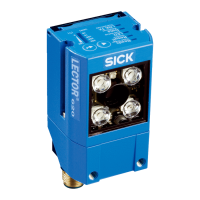ONLINE HELP SOPAS Chapter 5
LECTOR®620
Parameters
8013778/Y269/2013-11-27 © SICK AG · Germany · All rights reserved · Subject to change without notice 29
5.4.1.1.1 Reading distance
The Reading distance parameter is used to set the distance between the LECTOR
®
620 and
the object. The reading distance is used to modify the depth of field of the LECTOR
®
620 at
the installation location.
The value can be entered manually in mm or set automatically using the Auto button.
To avoid disruptive reflections on the object surface, the LECTOR
®
620 should be in-
stalled at a suitable fixing bracket (see installation information).
The reading distance influences the minimum code resolution and the size of the reading
area:
• If the reading distance is small, smaller codes can be read.
• A larger reading distance increases the reading area. The reduction in image brightness
caused by this is compensated for by the brightness control and, if necessary, by increasing
the shutter time.
5.4.1.1.2 Auto
Pressing the Auto button calls up the Auto Setup wizard for automatic configuration of the
reading distance.
For the reading distance to be adjusted automatically, a suitable object with contrast chan-
ges or edges (e.g. code, text, or other structures) must be placed in the reading area.
A prerequisite for automatic configuration of the reading distance is a certain basic
brightness at which the structures in the image are visible.
5.4.1.2 Exposure time
The time frame for taking an image is defined in μs via the parameters for the Exposure time
group.
• A short exposure time can accommodate high object speeds. As this causes the image
brightness to decrease, it may be necessary to adjust the signal amplification (Exposure
time). This does, however, increase the image noise.
• A long exposure time offers a high level of brightness and therefore minimal image noise.
This is the optimal setting for stationary or slow-moving objects.
5.4.1.2.1 Exposure time
The time frame for taking an image is defined in μs via the Exposure time parameter. The
exposure time can be set via the slide control.
• A short exposure time can accommodate high object speeds. As this causes the image
brightness to decrease, it may be necessary to adjust the signal amplification (Brightness).
This does, however, increase the image noise.
• A long exposure time offers a high level of brightness and therefore minimal image noise.
This is the optimal setting for stationary or slow-moving objects.

